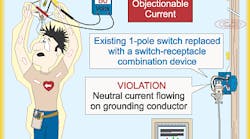What's the harm in objectionable current, and how do you eliminate it?
You should know 250.6 says objectionable current is not to flow on grounding and bonding paths, but do you know what it is, why it's dangerous, and how to remove it? First, though, you need to know its causes.
Objectionable current on grounding and bonding paths comes from an improper neutral-to-case bond that creates a parallel path for neutral current to return to the power supply via metal parts of the system. It occurs in three common scenarios:
-
When a neutral-to-case bond exists in either a panelboard not part of service equipment or at the transformer and the secondary panelboard.
-
When a generator system's transfer switch doesn't open the normal power grounded (neutral) conductor, and the generator's ground and neutral conductors are bonded together.
-
When the bonding path serves as a neutral conductor, which happens when a 125V receptacle is installed at a switch location where a grounded (neutral) conductor is unavailable, and the equipment grounding conductor is used as the neutral.
Objectionable current on grounding and bonding paths can raise the temperature at a loose fitting enough to ignite combustible materials. Arcing at loose fittings is very dangerous in areas that contain ignitable and explosive gases, vapors, or dust.
This current can also result in dangerous voltage on metal parts of electrical equipment. The possibility of death from ventricular fibrillation exists any time the voltage is more than 30V.
Nuisance tripping of a ground-fault protection device can occur if neutral current returns on the equipment-grounding conductor, instead of on the neutral conductor. A circuit breaker with ground-fault protection required for a 480Y/277V, 3-phase system, of 1,000A or more, uses the residual current method to detect a ground fault (230.95). On a 3-phase, 4-wire system, the trip unit will sum the vectors of the currents in the 3-phase conductors and the neutral. When no ground fault is present, the sum of the vectors of the currents flowing on the 3-phase conductors and the neutral will equal zero. Any current flow not equal to zero is a ground-fault. Depending on the impedance of the parallel neutral paths, the ground-fault protection relay may see current flow above its pickup point, causing the device to open the circuit when no fault exists.
If multiple improper neutral-to-case bonds exist and a ground fault occurs, the ground-fault protection relay might not operate because some of the ground-fault current returns on the neutral conductor, effectively bypassing the device.
Not only is objectionable current dangerous, it can cause serious power quality problems, so you must address it by grounding and bonding electrical installations in accordance with Art. 250. Pay special attention to your neutral ground bonds. It's helpful to draw the current paths in CAD or on paper so you can see, for example, if neutral current will flow on grounding or bonding paths.




